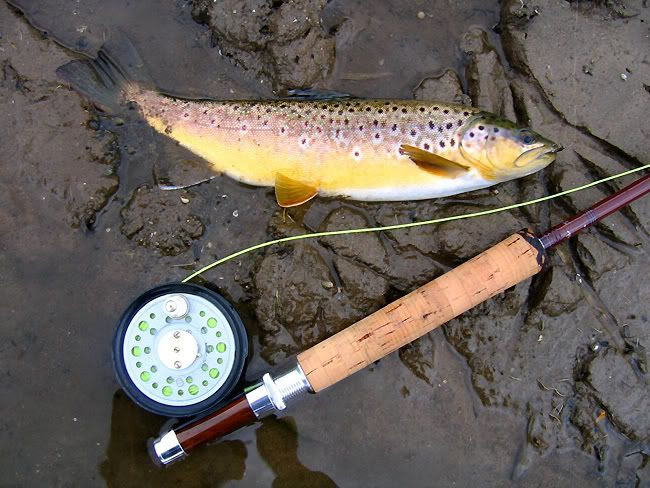

I fished the western Wisconsin twice last week and spent the Saturday fishing NE Iowa, while visiting my in-laws. With three outings in a week, I finally feel like I am catching up with my fishing. The weather was gloomy for the most part of the week-I even got soaked on
Rush river on Thursday. However, this type of weather is the greatest for fishing, and all three days were truly magnificent, with double digit catches on each outing.
Both Wisconsin trips started in similar fashion... I would drift

buggers or weighted nymphs during the morning, occasionally switching to size 22 midges for bank sippers. Baetis hatch would start little after 11am, and fish would turn on. There were still some little stoneflies around, and I spotted very few Dark Hendricksons and a single black caddis. The river was slightly off color and little high.
On both days I found pools below riffles where stacked fish would gulp little olives. The feeding on rainy Thursday was so intense, that the churned surface full of swirls and boils reminded me of blitzing

stripers on the NE coast...I don't think I ever saw that many trout feeding at the same time. While half emerged duns caught plenty of fish on Monday, PT nymphs and
Starling & Pheasant wets took fish consistently on both days. It was greased line fishing in classic style: switch and single spey cast down and across, mend the line, follow the swing, and allow enough slack in the system to hook the fish successfully. Each cast would often bring a
hungry trout. I didn't get any giants, but all trout were well conditioned and feisty fighters
(notice the footprints of another "fisherman" next to the trout, photo above.) 
Iowa creeks were not in the greatest shape, due to the heavy downpours during the week.
Waterloo was murky and high, but I decided to fish it, since it can produce big browns when the water is slightly off-color. The visibility ranged from 6 to 12 inches-not great but still fishable.
I started the day with
Waterloo Leeches, Siliclone Sculpins and the super-fast polyleader. Size 2 sculpin didn't prove too big for average Waterloo browns, fished off the bottom in slower pools.

Around noon, a heavy hatch of Baetis materialized, followed by Dark Hendricksons. The unfavorable water conditions were responsible for the lack of intense surface activity, but in quiet eddies there were enough surface feeders to satisfy a dry fly purist. I fished my new Sceptre glass for the most part of the week, and it proved again to be very versatile stick. I switched from polyleader to furled thread leader and
Hendrickson CDC Cripple dry. Wild browns from Waterloo, just like their Rush river cousins, were in excellent shape and hungry. The fish keyed on Hendricksons
(title photo) after the Baetis
(left) hatch tapered off.

The egg laying spinners hovered over the riffles, while the duns were still emerging, often intercepted by red-winged blackbirds in the mid-air.
Hendrickson umbrella duns with moorhen front hackle worked like a charm on selective feeders.
I had to leave around 5pm so I wouldn't miss the family dinner... Fish were
still rising along the rocky bank, enjoying the mayflies of spring.




